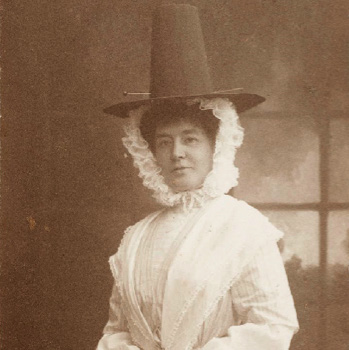Edith Mansell-Moullin
The full resource is FREE to all registered users of the website
If you are not already registered you can sign up for FREE website access to download the full resource.

- Born: 1858
- Died: 1941
- Occupation: Social campaigner
- Claim to fame: Prominent Welsh campaigner for women’s suffrage
Early years
Edith Thomas was born in England but of Welsh heritage. As a young woman, she was active in aid work in the soup kitchens and poorest slums of London. She married a renowned surgeon, Charles Mansell-Moullin, and they were both dedicated to social care and improving the rights of others.
Suffrage activities
In 1907, Edith joined the Women’s Social and Political Union (WSPU) and became a regular at the Kensington (London) branch of the WSPU, as well as a treasurer for the Church League for Women’s Suffrage (CLWS). She was present during the violent events of the ‘Black Friday’ suffrage demonstration in 1910 and went to prison in 1911 after taking part in a deputation to the House of Commons.
Edith’s husband Charles also supported women’s suffrage. He was active in the Men’s League for Women’s Suffrage
(MLWS) and, as vice president of the Royal College of Surgeons, was outspoken in condemning the practice of forcibly feeding women prisoners on hunger strike. He also tried to treat Emily Davison after she was hit by the King’s horse at the Derby.
In 1911, Edith was also one of those that illegally ‘resisted’ the government’s census survey as part of a wider suffrage boycott of it, by refusing to give the required information. At her home at 69 Wimpole Street, London, she wrote ‘No vote no information’ across her census form, along with other bits of graffiti. Her servants also did the same.
For the Women’s Coronation Procession in June 1911, Edith organised the Welsh women, which led her to form
the Welsh-based suffrage society the Cymric Suffrage Union (CSU). It was active in Wales, but also campaigned in London, targeting the Welsh population there by translating suffrage hand bills and government legislation into Welsh.
In 1912, Edith also formed a breakaway group from it, the Forward Cymric Suffrage Union (FCSU), which pledged itself to militant methods, to work for no political party and to act against any government and any candidates that refused women the vote. The FCSU members wore a red dragon badge with the motto: ‘O Iesu, n’ad gamwaith’
(O Jesus, do not allow unfairness).
Edith left the WSPU, partly due to its decision to stop campaigning once the war had started. The FCSU then gave its support to Sylvia Pankhurst’s working-class East London Federation of Suffragettes (ELFS) when it broke from the WSPU in 1914. Edith continued working with the FCSU until 1916, when ill health forced her to stop some of her activities. During the First World War, she campaigned for the miners in Wales and for women to receive equal pay to men for doing men’s jobs. Following the war, Edith continued to work on social campaigns.
Glossary
- Women’s Coronation Procession: This was organised by suffrage campaigners as the ‘Great Demonstration’ to mark the coronation of George V.
- Men’s League for Women’s Suffrage (MLWS): This was formed to allow men to support the women’s suffrage campaign.
- Cymric: This means ‘Welsh’ in the Welsh language.
Questions
- Edith came from a respectable middle-class family and was a churchgoer; why do you think she was still motivated to physically fight for women’s rights?
- Do you think it made a difference that Edith was supported by her husband in her activities?
- Was it significant that Welsh women living in Wales and in London had their own campaigning group?
